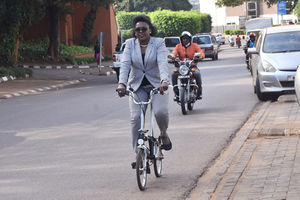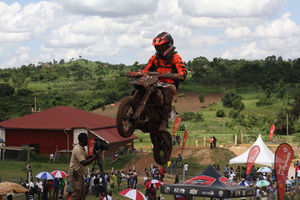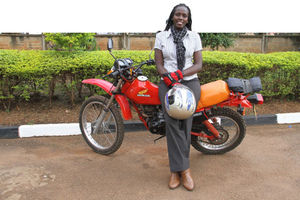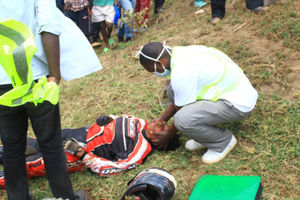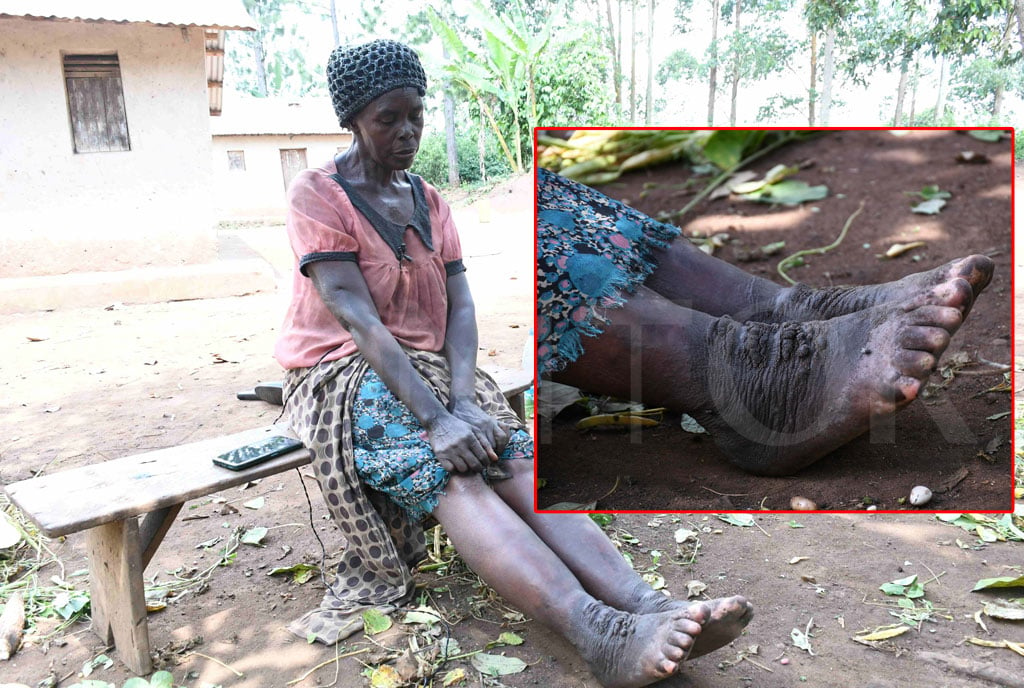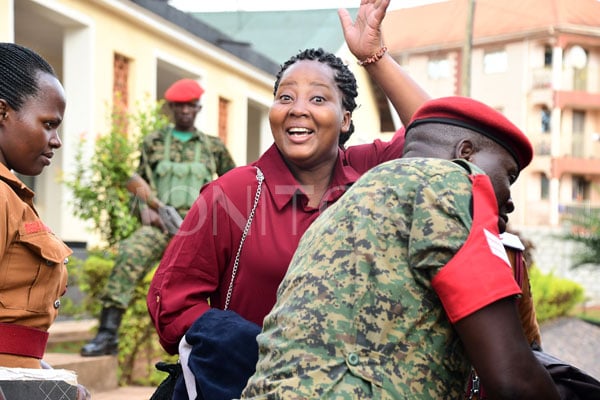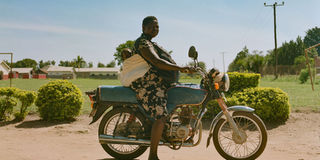
A woman on her boda-boda, carrying a black backpack at the front, and her baby on her back. PHOTO/Henry Robinson
Henry Robinson’s photo exhibition titled “Lela Pit” showing at the Afropocene Capsule Gallery in Kampala captures women and their bicycles and boda-bodas aka motorcycles as they go about their daily lives.
Curated by Tracian Meikle, the exhibition delves into the unique relationship between women and their bikes in Gulu and Lira districts in northern Uganda. Unlike Kampala, where women rarely ride bikes, despite the prevalence of boda-bodas for public and private transport, many women in the north use bicycles and boda-bodas for transport and moving goods. The exhibition that ran from June 24 to July 19, 2024 celebrated bike as the women’s travelling companion – wot ki lakwany lum iwangi (it is good to have a companion, especially when travelling).
This emphasis mirrors Robinson’s own practice of the Wandering Studio, a mobile photo studio that he developed in Kampala, whose name reflects his status as a traveller in East Africa. His work in the north builds on this wandering, translating the world through his photographer’s eye. The stunning photos capture the strength and resilience of the women of all age groups. The frames are lined with chains, a minor but thoroughly thought through detail that encapsulates the women-on-bike theme.
One of the crowd’s favourite majestic images is the one with a woman in a cream-flowered kitenge dress with a lace blue wrapper and blue and red rollers in her hair. She is standing with the bicycle in front of her. The beauty that this photo radiates is glorious and fascinating.
“This image shows an old working woman, who represents a matriarch in her community, and so her use of the bike as a tool can be clearly seen. She also has a strong presence that draws us in,” Henry told Saturday Monitor.
Outside the capsule, in the top right corner of the fence, a photo of a woman seated on her boda boda, carrying a black backpack at the front, her baby on her back was erected at The Female Boda Stage, an initiative, Women on Wheels, and one of the few places where women ride bikes in Kampala. This photo is one of the very first images Robinson took in 2023 that aptly captures the magnificence of the woman and her bike. “I found her at a school. She had gone to deliver lunch to her husband, who is a teacher. This was the first image I took starting this project, so it was fitting that it was the largest image,” Henry says. Another beautiful photo is that of a woman with her baby sitting on the top tube of her bike, and a bucket of mandazi (doughnuts) and wooden stool placed on the carrier under a big tree.

Henry Robinson of the Wandering Studio.
“She was riding to the market to sell mandazi. I found her fixing her bicycle under the tree, and we stopped to talk to her and make the portrait. It was the first day I was shooting and the bus driver acted as my translator,” Henry said.
There is one of a female police officer with wide smile dressed in a police uniform on a Yamaha motorcycle.
There is one of a woman in a white sleeveless shirt carrying a sports bike on her right shoulder. “She was a part of a bicycle club that one of my fixers runs in Gulu, who go for long cross-country rides. I thought it was good to show women who do not ride for transportation, but for leisure and exercise,” Henry says.
Robinson’s work reflects his practice with the Wandering Studio, a mobile photo studio he developed in Kampala, and builds on his experiences during his residency at Afropocene StudioLab in September 2022, during which he spent part of his time in northern Uganda.
The project is supported by Goethe Zentrum Kampala/Ugandan German Cultural Society in collaboration with Afropocene StudioLab.
When asked about the meaning of “Lela Pit,” Robinson replied: “the bicycle that feeds. The Lela (bicycle) is Gulu specific but the Pit (feed) is a word shared between Lira and Gulu. I choose Gulu because the exhibition focused more on the images I made in Gulu.”
According to Tracian, in the first series, Robinson captures the women in transit, practising a quick frame method that allows him to pose the women as they are. “The relationship between the woman and her bike is highlighted.”
In the second series, Robinson takes the Wandering Studio practice to Gulu, Tracian says. “He builds a backdrop to take studio shots in the tradition of African photographers such as James Barnor and Seydou Keita, who used studio photography to canonise everyday life on the continent. With this approach, Robinson experiments with more daring poses that enhance the relationship between the woman and her bike.”

A woman carrying a sports bike on her right shoulder. PHOTO/Henry Robinson
“Here, the bike becomes almost an appendage of the woman, showcasing her control over the tool and the way she wields its power to carry out her wishes,” Tracian adds. “In 2022, I came to Uganda for the first time for an Art residency (Afropocene) and spent the first two weeks travelling around Kampala in cars, buses, especially boda-bodas, which were a great means to see the city. When I went to Lira accompanying one of the mentors of Afropocene, I was shocked at how women have normalised riding bicycles,” Robinson explains inspiration behind this photographic project.
“The possibility to move from point A to point B is vital. Being a heavily agricultural community, transporting crops from the farm to market is important. And these women ride produce to markets with ease. This goes back to the title of the exhibition Lela Pit - the bike that feeds,” says Robinson.
He says the women he spoke to, own their bicycles. Asked how he went about taking these portraits, Robinson said: “The first few times I visited Lira and Gulu, I spent time speaking to women in transit or in public space. My fixer/translator spoke to the women and I would come in to make portraits or making adjustment in the poses.” Robinson worked mostly in Jamaica and the UK as a portrait photographer and he longed to employ some of the techniques he learnt to his own project. He focused on the woman and her tool, and this is why he decided to construct an outside backdrop for the images.
Asked about future plans for this project, Robinson says: “The images shown are a small proportion to what I have created. I am planning to publish a book from these images and hopefully organising more exhibitions.”
Henry Robinson Bio
Henry Robinson is a Uganda-based visual artist born and bred in Jamaica. He has worked in film and photography in the Caribbean and the UK. He uses portrait photography to explore what intrigues him about his subjects, answering questions about them with each shot. In addition to working with numerous commercial clients such as Puma and Google, his work has been featured in Plantain magazine and exhibited at King’s College in London.
